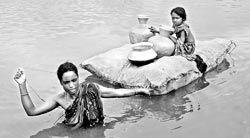
S. Asia flood waters recede but disease stalks millionsDHAKA, Saturday (AFP) – Muddy waters receded in Bangladesh and other parts of South Asia today but disease and hunger stalked millions of people hit by the worst monsoon flooding in decades. The inundation has been linked to at least 2,200 deaths in India, Nepal, Bangladesh and Pakistan, the United Nations said in a statement, as illness loomed over a vast number of people. Diseases such as diarrhoea, dysentery, cholera and typhoid threatened the millions affected by the deluge who still lack safe drinking water, medicine and hygienic food. “Even in the worst floods in 1998, we did not have as many patients. It's like a war,” said Ramzan Ali, the manager of Bangladesh's biggest hospital for diarrhoea sufferers in Dhaka, the country's capital. “We have put up tents in the parking lot and open spaces to set up makeshift wards,” Ali said. Some 1,000 patients were admitted with diarrhoea on Friday, Ali said.
More than 70,000 people have been hospitalised with water-borne diseases, said Aisha Akhter, the head of the Bangladesh government's health control room. More than half of those patients had diarrhoea amid an acute shortage of clean water, the official added. Nearly 10 million people have been affected in low-lying Bangladesh but five of its 38 districts hit by the inundation were now “flood-free” and water was receding elsewhere, government spokesman Aminul Islam said. UN Emergency Relief Coordinator John Holmes announced in a statement that the world body would provide up to 20 million dollars for relief operations in South Asia.“For most families affected by these floods, the recovery of their livelihoods will be arduous and protracted,” said Holmes. In India's eastern state of Bihar, one of the worst hit, most rivers were flowing below danger levels. The torrential rains had affected nearly 15 million people in 7,255 villages, officials said. The situation was also better in the Indian states of Uttar Pradesh and Orissa, where water levels were falling, officials said.“While the flood situation is improving it will take six to seven days for it to normalize and that also if there are no fresh rains in this period,” said Uttar Pradesh relief commissioner Umesh Sinha. Indian Air Force helicopters and army motor boats had ferried relief supplies to affected people, officials said. “Fortunately, we haven't had heavy rains in the past few days,” said Marzio Babille, the country head of the United Nations Children's Fund. But many were still at risk from disease, he added. “The situation is improving,” Babille told the Press Trust of India, but “we are very worried about the outbreak of diseases like malaria, cholera, diarrhoea and measles.” People in remotest areas faced serious food shortages, raising concerns about malnutrition too. “Under-nutrition and malnutrition threaten the lives of such people most, and in our assessment, they would be major factors in increase in morbidity in the coming days,” he said. The subcontinent's annual monsoon rains from June to September are crucial for farming, which remains key to the South Asian economy, but the heavy downpours can also bring death and destruction. “We foresee a 90 percent loss in vegetable growth which will have a grim impact on per capita nutritional intake,” warned B.C. Chowdhury, the chief researcher at Bihar's Agriculture University. “In very simple words, millions will go hungry if this crisis is not averted very, very quickly,” said doctor A.K. Jha in Patna, Bihar's state capital. The United Nations has described the flood situation in India and its neighbouring countries as the “worst in living memory.” Government figures indicate that more than four million hectares (10 million acres) of crops have been damaged, a UN statement said.
|
|| Front
Page | News | Editorial | Columns | Sports | Plus | Financial
Times | International | Mirror | TV
Times | Funday
Times || |
| |
Copyright
2007 Wijeya
Newspapers Ltd.Colombo. Sri Lanka. |
